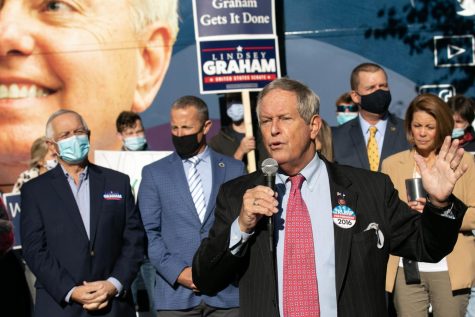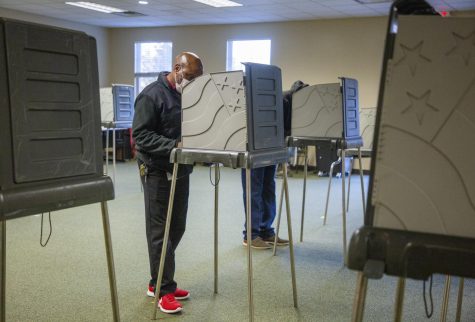Everything you need to know about North Carolina’s U.S. Senate race
There is a lot of uneasiness in anticipation of this year’s midterm elections. One of the key races to determine the makeup of the nation’s Senate will be right here in North Carolina. Senator Richard Burr is not running for reelection, which leaves an empty seat that many North Carolina Republicans and Democrats are fighting to fill. Since the Senate is split 50-50 between both parties (two Independents caucusing with Democrats), every seat counts in this election. Without a clear successor to Burr, North Carolina might become a pivotal state in November’s vote.
Currently Democrats control the White House with Joe Biden in office in 2022, as well as a majority vote in the House and Senate; however, prospective numbers for this midterm election show a lead in the Republican Party. The stakes for the U.S Senate Race are at an all-time high due to the unknowns of the future of the Senate.
U.S Senator Richard Burr, who has represented North Carolina for 28 years, announced his retirement in 2016. Burr was first elected to the Senate seat in 2004 beginning a standard term of six years; however, his service did not end there. From 2015 to 2020, he chaired the Senate Intelligence Committee. Senate retirements have left seats open in three swing states in this election: North Carolina, Pennsylvania and Ohio.

What is the key information to understanding this midterm election?
The person elected, taking Senator Burr’s place, will serve as one of the two representatives in the U.S. Senate. Their term will last six years. A third of the Senate will also be elected in this cycle.
There are two voting dates for the midterm elections—a primary election day and general election day.
Primary elections were originally scheduled for March 8, 2022 but were delayed due to redistricting issues—more on that later. The new primary date is May 17, 2022. On this day, voters will vote for one nominee for the party they are registered with.
The general election day is Nov. 8, 2022. On this day, voters will elect one person from any party to be the next senator.
So, about that redistricting plan?
Each state redraws their voting district lines every 10 years in accordance with the census. The redistricting plan based on 2020’s census was gerrymandered and rejected by Governor Roy Cooper. The districts are being redrawn, therefore delaying the state primaries until the districts can be considered fair.
District lines determine which candidate is elected from each section of the state. As the population increases and people relocate, the government is responsible for maintaining an equal number of people across the districts.
Senators represent the entire state, so they are not affected by redistricting except when it comes to voting day. The general election date was pushed back over two months due to this controversy.

Where are we?
Nadine Gibson, a political science professor at UNCW focuses on American politics, political behavior, elections, state government and methodology.
If you don’t know what’s going on, you are not alone.
“Right now, we are in the ‘invisible primary’ phase of the race. This means that the parties are winnowing down candidates before a single ballot has been cast,” said Dr. Gibson. This period is a time for candidates to prove themselves along the campaign track—a time to raise money and solidify themselves as viable candidates in the public’s eyes.
“Even people that do pay attention to politics are oftentimes burned out,” said Aaron King, a UNCW professor that teaches on American political institutions and research methods. “Of course, as elections approach, more people pay attention. This is especially the case in presidential elections, but attention goes way down in the midterm elections, and even more so in primary elections.”
“The problem is that many people don’t pay attention to primaries even though these are the races where parties choose who the nominees will be on the general election ballot in November,” said King.

Who are the candidates?
The Seahawk reported on all the candidates running for this office back in July; however, the race has changed since our last coverage.
There are now six Democratic candidates including Cheri Beasley, Chrelle Booker, Keith Davenport, Tobias LaGrone, Rett Newton and Richard Watkins.
The Republican candidates include Jennifer Banwart, Ted Budd, Kenneth Harper, Pat McCory and Mark Walker.
There are two candidates running as independents—Kimrey Rheinhart and Brenda Rodriguez.
Democrat Jeff Jackson campaigned at UNCW last semester but dropped out of the race on Dec. 9. He has endorsed Democratic frontrunner Cheri Beasley.
“I suspect that prominent members of the North Carolina Democratic Party and prominent donors signaled that Cheri Beasley was the most viable option,” said Gibson.
Pat McCory and Ted Budd were ready to send millions of dollars into the fight for one of them to take the Republican seat, which would be detrimental to the race. In order to stop that from happening, Jeff Jackson dropped out and was the first candidate to endorse Beasley.
Cheri Beasley is the frontrunner currently. In 2014, Beasley was elected associate justice of the North Carolina Supreme Court, flipping the seat from Republican control. In 2019, she became the first African American woman to serve as the chief justice of the Court.
The main issues Beasley is focusing on are accessible and affordable healthcare, creating jobs for a better economy in North Carolina, supporting small towns and agriculture and standing up for women’s rights, to name a few.
Much of the news about the upcoming election has been about Republican frontrunner Ted Budd. His focus is rejecting Biden’s presidential plans. He stands with law enforcement, wants to cut taxes, secure the border and support the Second Amendment in full.
What do voters think of the candidates so far?
The last time North Carolina saw a Democratic senator in office was in 2009, with Kay Hagan. Right now, the prospective Senate polls for the United States are almost too close to see a real difference in numbers. The ballots are evenly split with 42.9% of voters planning to vote Republican, 42.7% going Democrat and 14.4% unsure.
In North Carolina, Ted Budd holds a prospective 41.1% lead over Cheri Beasley for the Republican seat. Cheri Beasley’s prospective poll number sits at 37.9%.
What’s next?
The next step is the primary election on May 17. Candidates are gearing up for what may be one of the most historically significant North Carolina elections.
*Correction: A previous version of this article stated that “The last time North Carolina saw a Democratic senator in office was in 1999, with John Edwards,” which was incorrect. The article has been updated.












Bill Brady • Jan 27, 2022 at 4:26 pm
Actually, the last time NC sent a Democrat to the Senate was in 2009, with Kay Hagan – who served until 2015. Two people wrote this article and neither of you knew that???